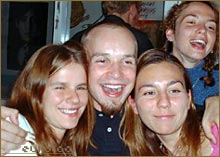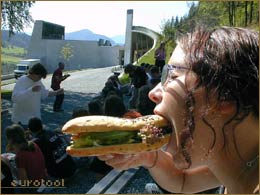Apply/Filling Advice/Group Initiative
Contents |
Quality & Formal Criteria's
A core group (those young people that initiate the idea and manage the project in all the phases): at least 4 of them between 15-25, at least one above 18 (or in some cases a youth worker/support person -no age limits apply) taking up the function of person responsible;
Duration from 3 to 12 months, incl. all the phases of the project (preparation, implementation, evaluation);
Innovation (how do young people see the innovation aspect of their initiative e.g.. in terms of theme, working methods etc): not necessarily absolute innovation, always depends in its context;
Local impact (the project should bring something new into the local community and usually more effect than only to the core group). Includes contacts or partners within the local environment, co-operation with local authorities (income matching, use of facilities, support, information channels, promotion, etc);
European Dimension: e.g. a website/publication in English, a newsletter via internet, preparation with partners abroad (consultation at a distance with similar groups in other countries). One way to understand different possible approaches is the model of ladder: Joint projects (contacting, perspective of networking projects), Mobility (although not always in the frame of initiative projects, can be a stimulation for getting young people ready for future youth exchange), Transnational working methods (e.g. elements of method of working of other country), European theme or topic (getting information from different countries and compare systems, trans-European projects of relevance to young people in different countries), Common framework.
Good practice: what we do in our community is probably also useful for other situations and contexts - a symbol of little rock that makes ripples in the water of the whole lake;
Youth led: as it is developed and run by young people it is a way to stimulate creativity and enterprise of youth, also to promote young people's needs.
For youth workers/coaches: there is a clear need to be aware and respect the target group you are dealing with, to adjust to their special needs.
3 levels of priority (in financial terms: normally up to 5000/up to 7500/up to 10000 Euro - check the possible adjustments with you NA).
The schedule for the Action Plans
Idea and preparation (contact your NA already with initial idea in order to get information on criteria, national priorities, funding amounts etc as well as support in project planning , e.g. training courses for core group members);
Deadlines (choose one based on when would you like to start your activities and costs) and application form;
Decision-making process: positive, negative, in-principle decision; Selection Committees (regional based system in some countries);
Contracts (in case of changes in project, contact your NA asap; promotion of YOUTH funding as one of the obligations of beneficiary etc);
Funding (priorities, system of 1st and 2nd payments);
Final Report.
Develop your idea individually What do you want to do when you get started with your project? Why do you want to do that? If you don’t know yet what to do, here are two suggestions: A: Do a SWOT analysis on your organizations potential for doing a group initiative. What are the strengths, weaknesses, threats and opportunities? On the basis of this analysis you can either work out a plan to improve the weaknesses or you can plan something new what you think will complement the strengths. B: Work out a plan that allows you to spread or multiply the things you have heard and learned to colleagues, other organizations or your National Agency (or in cooperation with them) or to promote group initiatives to your young people with fewer opportunities.
Phases and Crises of the Project
- DEFINE the objectives and aims together with the youngsters
- challenge to combine the objectives of the different actors (youth worker, youngsters, funders, etc)
- PLANNING conflicts in ways of working, different visions on the implementation of the project
- IMPLEMENTATION people that withdraw from the project
- slacks in motivation
- taking too much work on their shoulders
- so you should be flexible in the youth initiative
- EVALUATION thinking of what comes next – not only evaluate at the end : regular monitoring or asking for advice during the whole project
SEE RISKS AS CHALLENGES AND LEARNING OPPORTUNITIES (learn from mistakes)
European dimension
The European dimension is particularly important in the case of locally or regionally based youth initiatives. Group Initiatives projects should contain an European dimension.
However, it is not always easy to incorporate an European dimension into local contexts, that is to say into participants’ daily activities. The European dimension can be interpreted in different ways depending on different cultures across Europe.
The following tips may help to give an European dimension to local activities, either they are part of a Group Initiative or a Future Capital project.
The project’s theme is of European interest
The central theme of the project should reflect a topic of current European interest, such as immigration, UE enlargement, European institutions, European projects, European elections, etc.
The project shows similarities and differences between European countries The creation of the project should show a comparison of one or several specific issues in different countries around Europe, such as Europe and young people, Europe and employment, Europe through different arts and cultures, cultural diversity in Europe, different realities of European young people, etc.
The project activities promote values of European priority The main aim of the project could be to promote European priorities or European values such as social inclusion, equal opportunities for men and women, human rights and democracy, care of the environment, respect for other cultures, European citizenship, youth participation, youth information, etc.
The project reflects a common concern for European society The project should focus on any common concern in Europe such as social exclusion, racism, xenophobia and anti-semitism, drug abuse, alcoholism, crime, HIV, etc.
The project is an intercultural learning experience The project should provide space for mutual understanding between different cultures living in the same local community, such as co-operation between young people from different immigrant backgrounds, eg. between Roma and non-Roma communities, etc.
Cases of Crisis
- one problem is the change over of the youngsters – different topics that occur
- work on the group process if someone drops out – do something completely different
- also talk about relationships and the values behind the project that is done
- limit the duration if you think that long term commitment is difficult
- discuss problems with the group as they arise
- not only the youngsters can be an element of insecurity, but also a youth worker can drop out, or funding can be rejected – have a plan B ready
- important is to stimulate the youngsters
- it needs flexibility
- one should not only focus on the project but also on the process. Maybe the project is even more important than reaching the results
- also take care of the motivation of the youth workers, don’t end up in a spiral of negativity
- if there are problems, don’t be afraid to ask or involve others
- don’t always focus on the problems but also take a side step
- make sure that there is confidence and trust between youth workers and youngsters
- involve the people out of the environment of the youngsters to avoid opposition
- don’t get stuck in one problem – divergent thinking (a problem cannot be solved with the thinking that it created)

